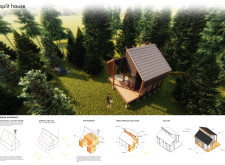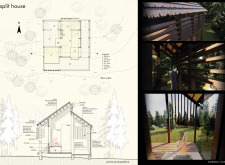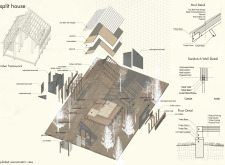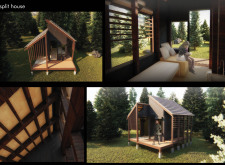5 key facts about this project
A significant feature of the Split House is its spatial layout that encourages an open living environment. The integration of large glass panels allows natural light to permeate the interior spaces, blurring the boundaries between inside and outside. This strategic approach to design promotes a well-lit, welcoming atmosphere conducive to relaxation and social interaction. Moreover, outdoor spaces are seamlessly connected with the interior, enhancing the overall living experience.
One of the unique aspects of the Split House is its innovative use of materials and structure. The project employs carbonated wood, plywood panels, and tree bark roof shingles, which not only contribute to the aesthetic appeal but also improve insulation and sustainability. This thoughtful selection of materials aligns with the overarching goal of reducing the ecological footprint while respecting local craftsmanship and tradition. Additionally, the artistic implementation of timber frames creates an intricate visual framework that supports the building's structural integrity.
The project also stands out through its functional design approach that includes multi-purpose rooms. The meditation room, for instance, serves as a tranquil space designed for introspection and mental well-being, illustrating the architects' understanding of the diverse needs of modern occupants. This flexibility in design allows for transformation and adaptation, making the house suitable for various lifestyles.
Furthermore, the architectural concept is executed through a carefully planned arrangement that addresses both site-specific conditions and environmental factors. The use of voids and open surfaces facilitates ample sun exposure while promoting ventilation, crucial for maintaining a comfortable indoor climate.
To delve deeper into the architectural plans, sections, and designs of the Split House, explore the project presentation for comprehensive insights into its innovative planning and execution. The detailed analysis of architectural ideas will enhance understanding of its unique contributions to contemporary architecture and sustainable practices.


























